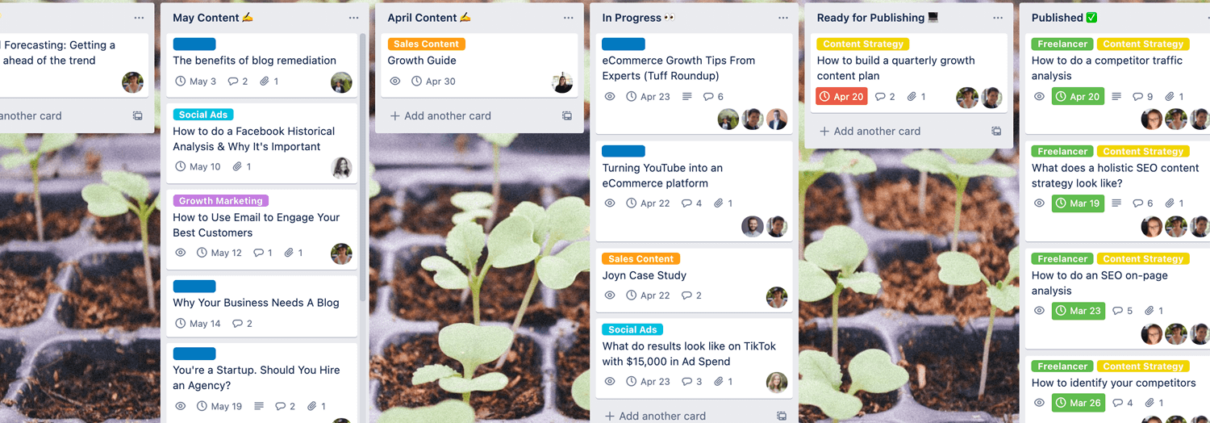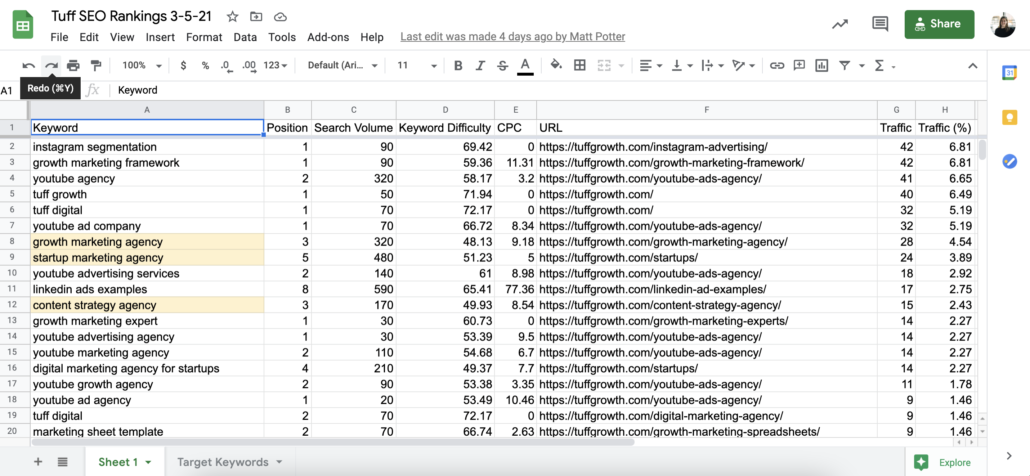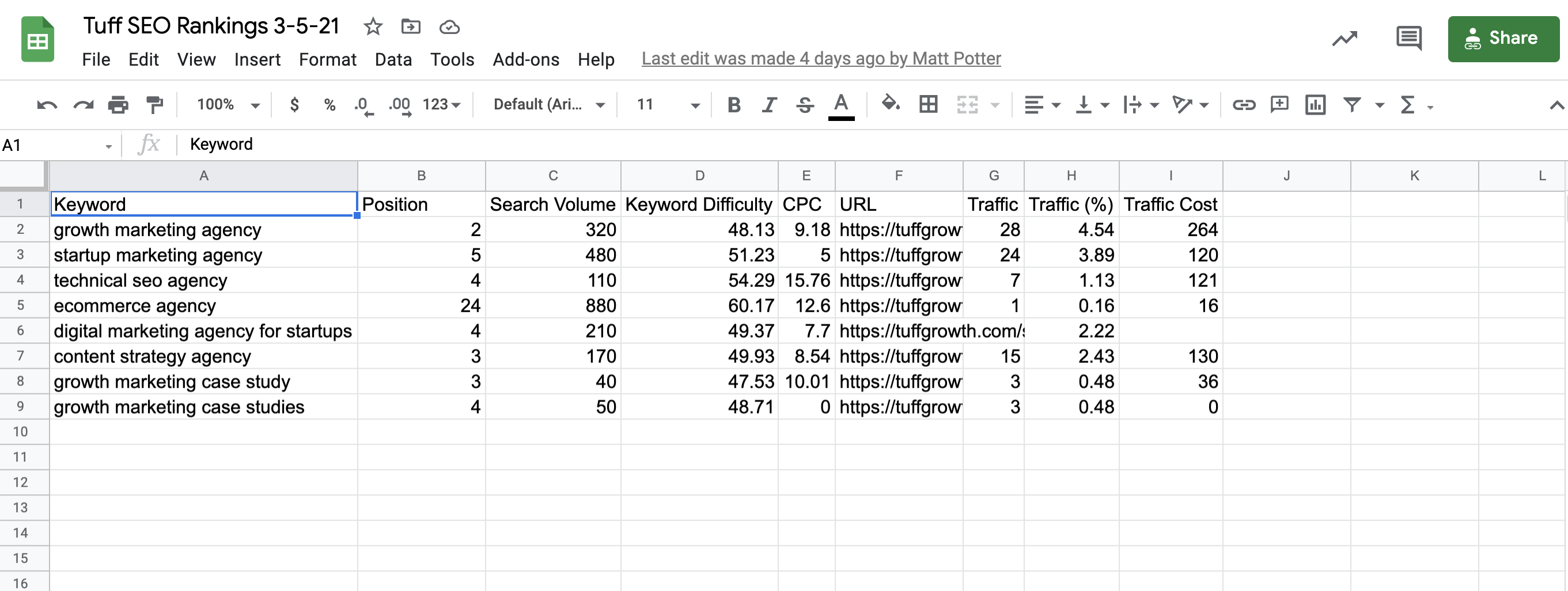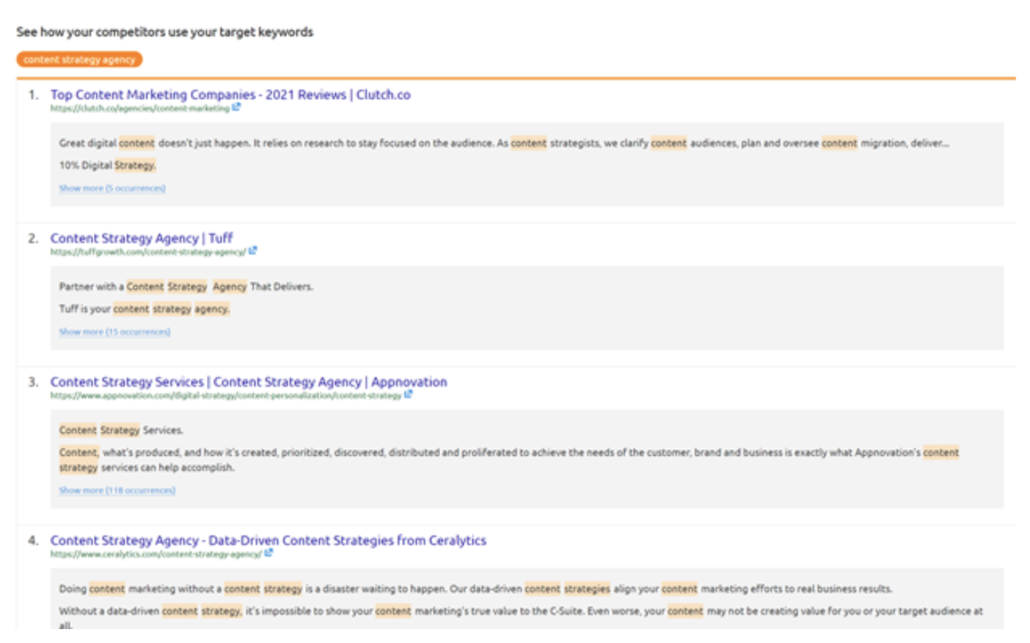How to Build a Quarterly Content Marketing Strategy (Using Tuff’s as an Example)
As a content marketer, you have one primary goal: to create content that converts viewers into life-long customers. It sounds simple, but it is far from easy, especially when you need to create consistent, quality content that regularly drops and is within budget. Like any huge task, it’s best to break it up into chunks that are more easily managed and still adhere to your long-term goals. This is why all successful content marketing starts with a solid content marketing strategy and why many content marketers struggle—because they don’t have one.
If you’re a content growth marketer that falls into the latter category, you’re not alone. According to a recent survey by the Content Marketing Institute, only 43% of respondents had a documented content marketing strategy, and 21% had none at all. How did so many professional content growth marketers fail to solidify a plan? If their experience is anything like mine, chances are they felt the pressure to meet deadlines, satisfy the client’s request, or thought that tactics that worked before would keep generating similar results.
But let’s all take a deep breath together. The more you put in on the back end, the easier your job will be on the front end, and more importantly, generate the results you and your client need.
At Tuff, we have a lot of experience creating quarterly content marketing plans that increase organic traffic for our clients. And since we practice what we preach, we do it for ourselves. So, let’s use Tuff’s quarterly content marketing plan as an example. This article will break down step-by-step how we form a strategy, create a quarterly content plan, and execute it.
What is a quarterly content marketing plan?
It’s just as it sounds. It is a 3-month plan to create topics that level up to your overall strategy. Why three months? Because anything more might be a waste of your time and effort. It didn’t take us long to go from “Oh, this COVID-19 thing should be only two weeks long” to us still dealing with it more than a year later. Plus, planning only three months out means you aren’t married to anything mentally. It is a lot easier to stick a fork in four topics than 12. In short, Tuff plans three months out because it lends us enough time to create an editorial calendar without scrambling, and it provides plenty of slack for us to quickly adjust our plan so we don’t miss out on timely events and topics.
Step One: Research what people are searching
Like any good plan, it all begins with research. At Tuff, we use content marketing to generate organic growth for our clients and ourselves, so research starts with keywords. And yes, keywords are still important, even if how they are used has changed. Let’s start with what we did for our website. We used our good friend, SEMrush, and their Keyword Magic Tool to determine what terms surrounded our industry—growth marketing. And, well, we got a lot of results back.
This is just a snapshot of the 14,000+ semantically related keywords.
Step 2: Put your keywords into focus
So, we had our 14,000 keywords, and we are good to go, right? Nope. A content strategy that goes after 14,000 keywords isn’t a strategy, and if so, it’s a really bad one. We had some refining to do.
As part of our SEO analysis, we removed anything that didn’t make sense to go after. “Market growth” with 1,300 searches per month and “stock market growth by the president “with 590 searches had some decent volume, but that isn’t what we are really about. So, we removed those right away. Same for any similar terms like “stock market growth,” “free market economies,” and “TD money market.”
Next, we sorted our list by keyword difficulty. The higher the percentage, the harder it is to get your content to rank for these terms. We started looking for keywords that were below 70%. Mind you, 70% is still challenging, but not impossible, especially with the right content surrounding those keywords.
Then, we went through our sorted list and focused on the search terms that we wanted to rank. That doesn’t mean the ones with the most search volume, but the search terms that we knew we could build expert, authoritative content around to build trust and attract the clients that are a great fit for our agency. This is basically what we do for retailers, eCommerce sites, B2B companies, etc., when we create buyer personas which are a detailed description of someone who represents your target audience. This gave us a list of around 1,400, so making progress. But we weren’t done.
Remember, this is how to create a quarterly content marketing plan, so we need to break this list down even more. We wanted to look at what we were already rankings previously and build upon that success.
If we are already ranking, why do we need to build more content? Because the search engines are constantly reevaluating rankings, and if you have content that is too dated, too brief, and/or not enough of it, the search engine algorithms will drop your rankings. As growth marketers well know, this is a “what have you done for me recently” type of industry, and the search engines have that mentality as well.
Okay, so now we have a very focused list to start building our quarterly content plan. The keywords are industry-specific, have low competition, and (bonus!) we have some momentum to build off. Now to start creating topics in our quarterly content marketing plan to help drive organic growth.
Step 3: Content topic research (yup, more research)
Now that we have our target keywords, our client (or buyer) personas, we can start researching the type of content we need to create to rank and attract the clients we want. We can go back to SEMrush and use their SEO Content template feature to help get an idea of what type of content is ranking for these keywords. Let’s look at “content strategy agency” and see what we can dig up:
We can see that we aren’t the only ones going after this keyword. There is no surprise there, but what we can also see is the content that is ranking for these keywords. Let’s look at the first result:
This article is primarily an aggregated list of “content marketing agencies,” so this isn’t something we want to duplicate or improve. However, we can learn how they used their primary keyword and semantically related keywords in their meta title and meta descriptions to rank high in the SERPs. What this article is missing is terms around a content marketing agency, such as “What is a content marketing agency and how can it help your brand?”, “what does a content marketing agency do?” and “Do I need a content marketing agency?” If we create content that answers questions that prospective clients are searching for, this is not only going to help us rank but also convert.
We will go through this process for each of our targeted keywords and create topics and content that will focus on these search terms, user intent, and answer PAAs. The main thing to keep in mind is what content will be helpful for the reader because that is what the search engines are asking. So, what did we come up with? Well, as you can guess, something around a content marketing strategy.
This title focuses on our primary keyword and will answer questions on what clients can expect from a content strategy from Tuff. But we showed you just a part of the end result. How did we get here? Glad you asked.
Step 4: Creating a Content Calendar
We’ve done our research, more research, and focused on what we are going after. So, before we write a single word, we have to organize it all. This is where your content calendar comes in.
If you have enough resources, you can tackle multiple topics simultaneously. Still, if your resources are limited, you want to target your most important keywords based on traffic, as these are typically going to yield you the best results. This strategy is sound when you have good domain authority, but if you are new to the game, well, you need to pick your battles. This means looking at your focused keyword list and going after low-hanging fruit. In other words, you want to target keywords where you can make substantial gains without having to deal with a lot of competition.
Why? Because the more keywords you start ranking highly for, the more the search engines will respect your expertise, authority, and trust (E.A.T.). As you build upon your domain authority, it will be a lot easier to rank for more competitive search terms. At Tuff, we decided to take a divide and conquer approach.
Each month we would focus on one keyword and produce 4-6 pieces surrounding these. We also wanted to create a holistic approach because our strategies are never siloed. It’s important to make sure your content calendar is still grounded in your overall strategy. For Tuff, our is to rank number 1 for “growth marketing agency,” so no matter what we create, it should ladder up to this. Luckily, content marketing is a big part of how we help our clients grow, so it’s a natural fit for us to tie in “content strategy agency” topics into “growth marketing agency.” But let’s back to the content calendar.
We knew that we wanted to build upon our expertise in content marketing, and “content strategy agency” had decent search value (170 per month) and low keyword difficulty (49%). Let’s take a look at what Month 1 looks like:
All of these topics tie into what a “content strategy agency” can do. We took our advice and created content that provided expertise, authority, and, hopefully, trust. We also perform keyword research, competitor analysis, and content design for each topic so the content can be easily digested. This means adding enough images with optimized file names and alt text and structuring it, so there are no giant blocks of text. For longer posts, we also make sure to create internal jump links. It’s not enough to get your content to rank. You also want to make certain people actually read it because a high bounce rate will most definitely affect your SEO. Plus, we strive to create content that people want to share.
Step 5: Rinse and repeat
For months two and three, we focused on “eCommerce agency” and “startup marketing agency,” respectively, going through a similar process that we did for month 1. Remember, we are not creating siloed content. Each of these leads up to our primary focus, “growth marketing.” And if we planned this right (which we did), we should crosslink these posts to create a content web easily. Having a good cross linking strategy ensures that your readers can find more great information without searching all over your site (or your competitors), and it increases time on site, which we know is good for our organic growth.
Step 6: Set your cadence
Once you have your calendar organized and content briefs for each topic, you can begin writing. But you need to think about your cadence. Even if you have the resources to jam all of it out in a week, you don’t want to upload it all at the same time. It’s best to create a steady drip so that both Google and your readers don’t get overwhelmed with the amount of content, and it gives them reasons to keep coming back. A steady drip also helps you build true, longer-lasting organic growth. If you upload them all at once, you may get a nice artificial boost, but it will fade as fast. Several studies show you the best time to publish content, but you also want to consider the type of content you are posting, and your competitors probably read these same studies.
Whichever you decide, keep it consistent.
What else do I need to know about creating a quarterly content marketing plan?
Organic growth is a long-term play. There are no quick fixes. Your content marketing efforts could take as long as 90 days to show positive results, but these results are sticky. Once you start ranking for specific terms, you should continue to move up in those rankings, that is, until someone else does it better than you. However, if you’ve produced good quality content, you don’t need to rewrite it every few months. You can update and expand on it using a remediation strategy. But that’s a topic for another post.
We’ve gone over quite a bit, but if you still have questions or you think this is something best left to the experts, then get in touch. We have created quarterly content plans for many of our clients, and one thing about going with a content strategy agency like Tuff, is that we have been there done that. You can lean into our expertise and grow your business the right way.
We’ve gone over quite a bit, but if you still have questions or you think this is something best left to the experts, then get in touch. We have created quarterly content plans for many of our clients, and one thing about going with a content strategy agency like Tuff, is that we have been there done that. You can lean into our expertise and grow your business the right way.

Ellen is the founder at Tuff and one of the team’s core growth marketers. She is a versatile marketer with expertise in multiple channels – from ppc to seo to email to others – responsible for the experiments and testing. She is happiest when she’s on the ski hill or outside pointing her mountain bike downhill.












